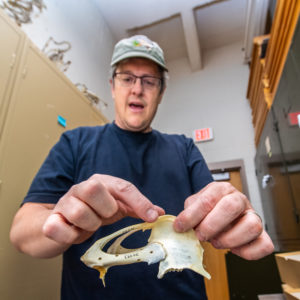Will Beetles Clean A Skull That Has Been Frozen For 4 Weeks

Keith Barker, curator of the Bell's genetic resources collection, gave a quick Q&A nearly our dermestids.
How long has there been a colony associated with the collections?
Nosotros accept had dermestids off and on for a long, long time. Recently our colony had died downwards, simply I got some beetles from the Science Museum and Sushma brought back some beetles from the Field Museum to kick get-go things once again. The bulk of skeletal preps in our drove started in 1949, and were prepared by our previous bird curator Dwain Warner, and so presumably the colony was started and so. Since then, we take cataloged most half-dozen,000 skeletal specimens, all prepared by feeding bird carcasses to beetles.
What are they eating these days?
They are eating birds nigh at the moment. They often also eat mammals, and sometimes fish. Colonies that eat a lot of fish seem to prefer that, colonies that eat birds and mammals likewise. They don't like to switch. Generally, dermestids eat everything from swans to tiny warblers, deer skulls to shrews.
Any interesting facts to add?
It is very common for people working with beetles to eventually develop an allergy to them, so we wear personal protective equipment including a lab coat, gloves, and masks when working with the colony to prevent this.

Sushma Reddy, Breckenridge chair of ornithology and our curator of birds, visited the colony recently to have some photos for united states and offer her take on the beetles.
I call back another interesting part of the story is the multi-week process of preparing skeletons. Dermestid beetles are still the neatest and cheapest mode to make clean out skeletons from carcasses. In birds and mammals, we ordinarily dissect a carcass after taking some standard measurements past removing the skin/feathers/fur. For larger bodies nosotros likewise have out some of the muscle and organs to go far easier for the beetles to get to the bones faster. And so nosotros dry the bodies—I was told it was because the beetles preferred decomposable flesh, merely others recall the beetles don't care. It'due south not an exact science.
After a few days of air drying or freezer burning, the bodies are transferred to the beetle boxes. We place each trunk in a separate wire tray (usually custom fabricated by the curatorial staff) or paper-thin box because every bit the beetles gnaw away at the flesh, the skeleton may disarticulate, and we want to exist able go on the bones together. It can take a colony anywhere from a few days to weeks to make clean out a skeleton depending on its size. Then we accept to remove the skeleton by shaking off the beetles and larvae as much as possible. As a second precaution, we usually handbag and freeze each specimen to kill off any possible stowaways. A third precautionary step is to soak each skeleton in bleach to kill off whatever bacteria and such.
From my experience, each museum has its idiosyncratic improvised "equipment" for these processes. At the Bong Museum nosotros have a large (100+) collection of yogurt containers that we use for the soaking procedure. As Keith once said, "Someone ate a lot of yogurt to help out the collection." Finally, we wash out the skeletons in water to remove bleach (which can continue to corrode the bones otherwise) and pick out the bones to dry and so store in pocket-size boxes in the collections cabinets.
In some cases, someone will carefully write the catalog numbers on the large basic so that when scientists lay out the bones in a comparative series they don't become mixed upward. Beingness able to write neatly and in small blazon is a disappearing skill—at the Field Museum, they had a lone octogenarian volunteer who came once a week to do this one job. Nosotros need to detect the Twin Cities equivalent.
We tin can maintain a colony in a large aquarium tank or rubbermaid box for several years with minimal maintenance. They only demand a scrap of substrate to burrow into, flesh to eat, h2o to drink, and warm temperatures to be happy.
Source: https://www.bellmuseum.umn.edu/blog/dermestid-colony/
Posted by: belfordblince.blogspot.com


0 Response to "Will Beetles Clean A Skull That Has Been Frozen For 4 Weeks"
Post a Comment